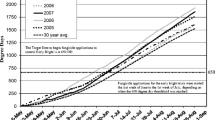Abstract
Potato early dying disease, caused byVerticillium dahliae, may be either suppressed or controlled by a variety of procedures. These methods include the growing of resistant cultivars, attention to cultural management, utilization of pesticides, and solar heating of soils. The greatest successes in control of Verticillium wilt have been achieved with the use of either soil fumigants or clonal resistance, but these approaches have been restricted. Widespread use of fumigants has been limited by cost, and the lack of commercial acceptance has often restricted the utilization of resistant potato cultivars. The Katahdin and Targhee cultivars are currently available with resistance and/or tolerance to this disease. The Russet Burbank potato also possesses a limited degree of resistance to the fungus, and with this resistance, the disease appears to be suppressed by optimal growing conditions. In potato fields that have been cropped for several years, disease suppression in Russet Burbank was found to be related to methods of irrigation and increased nitrogen availability. It is suggested that improved utilization of resistant germplasm and effective use of biological control strategies may ultimately lead to economical control of this disease.
Resumen
La enfermedad de la muerte prematura de la papa, causada porVerticillium dahliae, puede ser eliminada o controlada por varios procedimientos. Estos métodos comprenden el cultivo de cultivares resistentes, atención prestada al manejo del cultivo, utilizatión de insecticidas y fungicidas y el calentamiento solar de los suelos. Los más grandes éxitos en el control de la marchitez por Verticillium se han logrado mediante el uso de fumigantes de suelos o resistencia clonal, pero estos métodos han sido restringidos. La aplicación amplia de fumigantes ha sido limitada por el costo y, a menudo, la falta de aceptación comercial ha restringido la utilización de cultivares resistentes de papa. Los cultivares Katahdin y Targhee están actualmente disponibles con resistencia o tolerancia a esta enfermedad, o con la combinación de ambas. Russet Burbank también tiene un grado limitado de resistencia al hongo y, con esta resistencia, la enfermedad parece ser vencida mediante condiciones óptimas de cultivo En los campos de papa que han sido cultivados durante varios años, se encontró que la eliminación de la enfermedad en Russet Burbank estuvo relacionada con los métodos de irrigación y un aumento en la disponibilidad de nitrógeno. Esto sugiere que una utilización mejor del germoplasma resistente y el uso efectivo de las estrategias del control biológico pueden finalmente llevar a un control de esta enfermedad, que sea económico.
Similar content being viewed by others
Literature Cited
Corsini, D.L., J.J. Pavek and J.R. Davis. 1984. Verticillium wilt and early blight resistant potato breeding clones. (Abstr.). Am Potato J 61:519.
Davis, J.R. 1981. Verticillium wilt of potato in southeastern Idaho. Univ of Idaho Current Inf Ser No. 564.
Davis, J.R. 1984. Relationships of plant nutrition and methods of irrigation to Verticillium wilt of the Russet Burbank potato. Pages 180–181.In: Abstracts of Ninth Triennial Conference Papers of the European Association for Potato Research. Interlaken, Switzerland, July 1–6, 1984.
Davis, J.R. and R.E. McDole. 1979. Influence of cropping sequences on soilborne populations ofVerticillium dahliae andRhizoctonia solani. Pages 399–405.In: Soil-Borne Plant Pathogens. B. Schippers and W. Gams, eds. Academic Press, New York. 686 pp.
Davis, J.R., J.J. Pavek and D.L. Corsini. 1983. A sensitive method for quantifyingVerticillium dahliae colonization in plant tissue and evaluating resistance among potato genotypes. Phytopathology 73:1009–1014.
Davis, J.R., J.J. Pavek, D.L. Corsini and L.H. Sorensen. 1985. Stability of Verticillium resistance of potato clones and changes in soilborne populations with potato monoculture.In: Proc of Soil-Borne Diseases of 4th Internl. Congress of Plant Pathology, Melbourne, Australia. (In press)
Davis, J.R. and L.H. Sorensen. 1983. Carryover effects of plastic tarping on Verticillium wilt of potato.In: Abstracts of Papers for 4th Internl. Congress of Plant Pathology, Melbourne, Australia, Aug. 17–24, 1983. p. 157.
Easton, G.D., M.E. Nagle and D.L. Bailey. 1975. Residual effect of soil fumigation with vine burning on control of Verticillium wilt of potato. Phytopathology 65:1419–1422.
Guthrie, J.W. 1960. Early dying (Verticillium wilt) of potatoes in Idaho. Univ of Idaho Res Bull No. 45. 24 pp.
Hoyman, W.G. 1974. Consequence of planting Norgold Russet seed infected withVerticillium albo-atrum. Am Potato J 51:22–25.
Hunter, D.E., H.M. Darling, F.J. Stevenson and C.E. Cunningham. 1968. Inheritance of resistance to Verticillium wilt in Wisconsin. Am Potato J 45:72–78.
Isaac, I., and J.A.C. Harrison. 1968. The symptoms and causal agents of early dying disease (Verticillium wilt) of potatoes. Ann Appl Biol 61:231–244.
Krikun, J. and D. Orion. 1979. Verticillium wilt of potato: importance and control. Phytoparasitica 7:107–116.
McMaster, G. 1959. A new concept in sprinkler irrigation. Univ of Idaho Progress Report No. 17. pp. 1–12.
Nnodu, E.C. and M.D. Harrison. 1979. The relationship betweenVerticillium albo-atrum inoculum density and potato yield. Am Potato J 56:11–25.
Powelson, R.L. and G.E. Carter. 1973. Efficacy of soil fumigants for control of Verticillium wilt of potatoes. Am Potato J 50:162–167.
Pratt, O.A. 1916. Experiments with clean seed potatoes on new land in southeastern Idaho. J Agric Res 6:573–575.
Puhalla, J.E. and M. Hummel. 1983. Vegetative compatibility groups withinVerticillium dahliae. Phytopathology 73:1305–1308.
Schnathorst, W.C. 1981. Life cycle and epidemiology ofVerticillium. Pages 81–111.In: Fungal Wilt Diseases of Plants. M.E. Mace, A.A. Bell and C.H. Beckman, eds. Academic Press, New York. 640 pp.
Author information
Authors and Affiliations
Rights and permissions
About this article
Cite this article
Davis, J.R. Approaches to control of potato early dying caused byVerticillium dahliae . American Potato Journal 62, 177–185 (1985). https://doi.org/10.1007/BF02852975
Issue Date:
DOI: https://doi.org/10.1007/BF02852975




